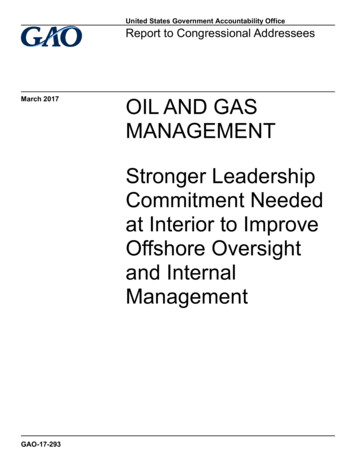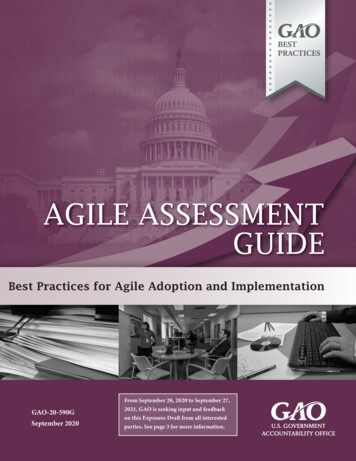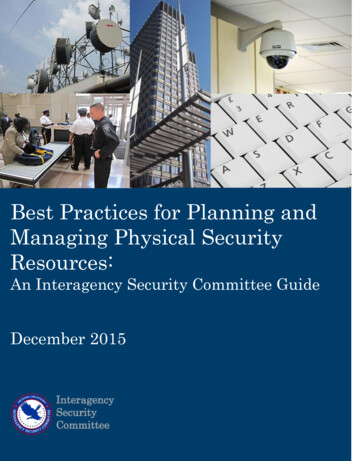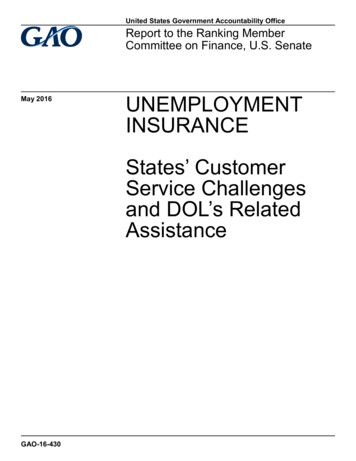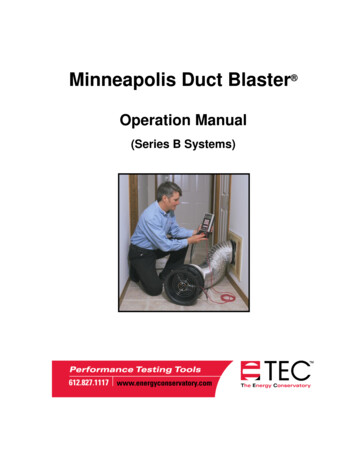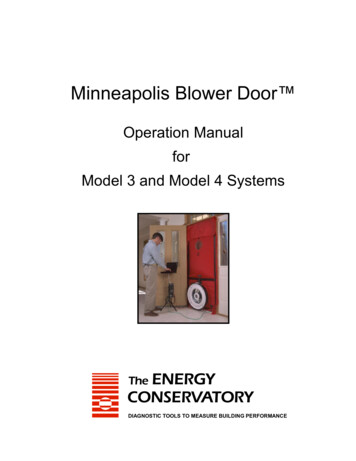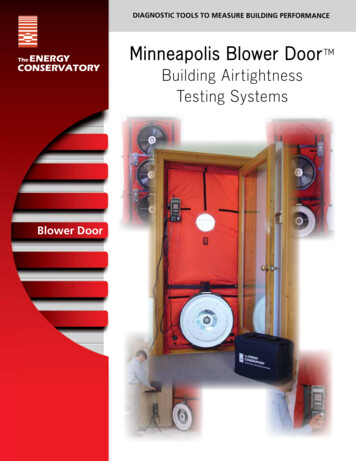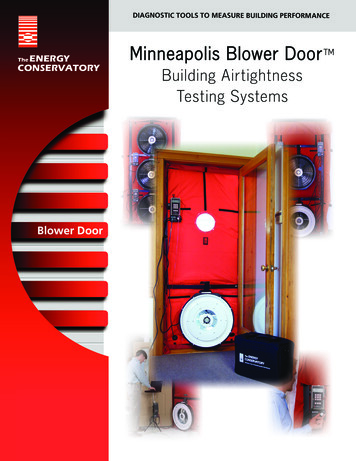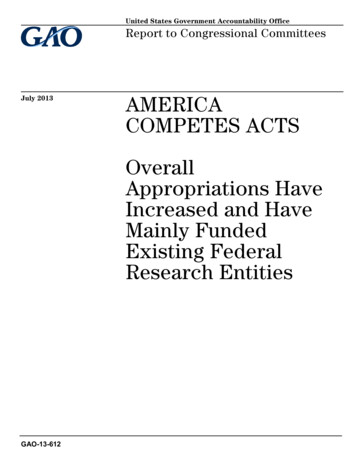
Transcription
United States Government Accountability OfficeReport to Congressional CommitteesJuly 2013AMERICACOMPETES ACTSOverallAppropriations HaveIncreased and HaveMainly FundedExisting FederalResearch EntitiesGAO-13-612
July 2013AMERICA COMPETES ACTSOverall Appropriations Have Increased and HaveMainly Funded Existing Federal Research EntitiesHighlights of GAO-13-612, a report tocongressional committeesWhy GAO Did This StudyWhat GAO FoundScientific and technological innovationand a workforce educated in STEMfields are critical to long-term U.S.economic competitiveness. Leaders ingovernment, business, and educationhave expressed concern about thenation’s ability to compete with othertechnologically advanced countries inthese fields. In this context, Congresspassed COMPETES 2007 andreauthorized the act with COMPETES2010, each with the overall goal ofinvesting in research and developmentto improve U.S. competitiveness.Among other things, the actsspecifically authorized funding forcertain programs.In fiscal years 2008-2012, 52.4 billion was appropriated out of the 62.2 billionauthorized under the America Creating Opportunities to Meaningfully PromoteExcellence in Technology, Education, and Science Act of 2007 (COMPETES2007) and the America COMPETES Reauthorization Act of 2010 (COMPETES2010). Almost all of these funds went to the entire budgets of three existingresearch entities—the National Science Foundation (NSF), the National Instituteof Standards and Technology (NIST), and the Department of Energy’s (DOE)Office of Science (Science)—including all of the programs and activities theentities carry out. Appropriations for NSF, NIST, and Science generally increasedunder the acts but did not reach levels authorized by the acts. In addition toauthorizing the budgets of these entities, COMPETES 2007 and COMPETES2010 specifically authorized funding for 40 individual programs, including someprograms within and some outside of these entities. Among those 40 programs,the 12 programs that existed before COMPETES 2007 received appropriationsand continue to operate. Six of 28 newly authorized programs were also funded.Of these 6 programs, 1—DOE’s Advanced Research Projects Agency-Energy,set up to develop new energy technologies—is continuing operations, 3 were notfunded in fiscal year 2012, and 2 were not fully implemented as of May 2013. Forthe 22 programs that were not funded, agency officials generally said that theydid not request funding in their budget submissions; most often this was becauseagencies had similar programs under way or could pursue similar objectiveswithin current programs. For example, Science said it did not request funding forthe Discovery Science and Engineering Innovation Institutes because it wouldhave duplicated other Science programs.COMPETES 2010 mandated GAO toevaluate the status of authorizedprograms. GAO examined (1) theextent to which funding wasappropriated under the authorization ofCOMPETES 2007 and COMPETES2010 and (2) what recent evaluationssuggest about how programs for whichthe acts specifically authorized fundingare working. To answer thesequestions, GAO reviewed relevantfederal laws, interviewed agencyofficials, and reviewed programevaluations for quality and content.This report contains norecommendations.For the fully implemented programs for which the COMPETES Acts specificallyauthorized funding, recent evaluations generally reported positive results, andsome evaluations provided suggestions for improvements. Recent evaluationshave been conducted for almost all of the programs that were implemented, orfor aspects of those programs. For example, studies of the Robert NoyceTeacher Scholarship Program found that the program has increased the numberof qualified science, technology, engineering, and mathematics (STEM) teachers,but also suggested that retention of teachers in high-need schools could beimproved.Appropriations under COMPETES 2007 and COMPETES 2010 in Fiscal Years 2008-2012View GAO-13-612. For more information,contact Frank Rusco at (202) 512-3841 orruscof@gao.gov.Note: Because of rounding, percentages do not add to 100, and dollars do not add to 52.4 billion.United States Government Accountability Office
ContentsLetter1BackgroundAppropriations Generally Increased but Fell Short ofAuthorizations, and Most Newly Authorized Programs Were NotFundedRecent Evaluations Generally Suggest Positive Results and SomeRecommend Improvements for Implemented ProgramsAgency Comments and Our Evaluation31317Appendix IScope and Methodology19Appendix IIPrograms for Which the COMPETES Acts SpecificallyAuthorized Funding21Appendix IIIComments from the Department of Commerce24Appendix IVGAO Contact and Staff Acknowledgments306FiguresFigure 1: Appropriations under the COMPETES Acts in FiscalYears 2008 through 2012Figure 2: Authorizations and Appropriations under the COMPETESActs for NSF, DOE’s Office of Science, and NIST, FiscalYears 2008 through 2013Figure 3: Implemented Programs for Which the COMPETES ActsSpecifically Authorized Funding, by Focus Area andAgencyFigure 4: Programs for Which the America Creating Opportunitiesto Meaningfully Promote Excellence in Technology,Education, and Science (COMPETES) Act of 2007 or theCOMPETES Reauthorization Act of 2010 SpecificallyAuthorized Funding, by AgencyPage i681122GAO-13-612 America COMPETES Acts
AbbreviationsARPA-ECommerceCOMPETES 2007COMPETES 2010COMPETES ActsDOEEducationIGERTMEPNISTNoyceNSFRecovery ActREURIPScienceSTEMAdvanced Research Projects Agency-EnergyDepartment of CommerceAmerica Creating Opportunities to MeaningfullyPromote Excellence in Technology, Education, andScience Act of 2007America COMPETES Reauthorization Act of 2010COMPETES 2007 and COMPETES 2010Department of EnergyDepartment of EducationIntegrative Graduate Education and ResearchTraineeshipHollings Manufacturing Extension PartnershipNational Institute of Standards and TechnologyRobert Noyce Teacher Scholarship ProgramNational Science FoundationAmerican Recovery and Reinvestment Act of 2009Research Experiences for UndergraduatesRegional Innovation ProgramOffice of ScienceScience, Technology, Engineering, andMathematicsThis is a work of the U.S. government and is not subject to copyright protection in theUnited States. The published product may be reproduced and distributed in its entiretywithout further permission from GAO. However, because this work may containcopyrighted images or other material, permission from the copyright holder may benecessary if you wish to reproduce this material separately.Page iiGAO-13-612 America COMPETES Acts
441 G St. N.W.Washington, DC 20548July 19, 2013The Honorable John D. RockefellerChairmanThe Honorable John ThuneRanking MemberCommittee on Commerce, Science, and TransportationUnited States SenateThe Honorable Lamar SmithChairmanThe Honorable Eddie Bernice JohnsonRanking MemberCommittee on Science, Space, and TechnologyHouse of RepresentativesScientific and technological innovation and a workforce educated in thefields of science, technology, engineering, and mathematics (STEM) arecritical to long-term U.S. economic competitiveness. In recent years,leaders in government, business, and education have expressed concernthat declines in federal funding for scientific research, coupled with ashortage of qualified students and future workers in STEM fields, threatenthe nation’s ability to compete with other technologically advancedcountries. For example, according to a group of leaders gathered by theNational Academies in 2005 and 2010 to examine U.S. competitivenessin the twenty-first century, scientific research and education arenecessary investments that will drive the economy and allow the UnitedStates to maintain the economic strength to provide services such ashealth care and national security in the current economic and fiscalclimate. 1For decades, the federal government has invested in scientific researchat a number of agencies and departments, including the National Science1The National Academies comprises four organizations: the National Academy ofSciences, National Academy of Engineering, Institute of Medicine, and National ResearchCouncil. The group gathered in 2010 was made up of members of the committee thatwrote the 2007 National Academies report Rising above the Gathering Storm: Energizingand Employing America for a Brighter Economic Future, which made recommendations toensure the United States maintains its leadership in science and engineering.Page 1GAO-13-612 America COMPETES Acts
Foundation (NSF), the Department of Energy (DOE), and the Departmentof Commerce’s (Commerce) National Institute of Standards andTechnology (NIST). The federal government also invests in STEMeducation through the Department of Education (Education), NSF, DOE,and other departments.Congress passed the America Creating Opportunities to MeaningfullyPromote Excellence in Technology, Education, and Science Act of 2007(COMPETES 2007) 2 with the overall goal of investing in research anddevelopment to improve U.S. competitiveness. The act also authorizedinvestments in education in STEM fields. In 2011, Congress passed theCOMPETES Reauthorization Act of 2010 (COMPETES 2010). 3 Together,these acts authorized 62.2 billion in funding from fiscal year 2008through 2012. For fiscal year 2013, COMPETES 2010 authorized anadditional 16 billion, bringing the total amount authorized under the actsto 78.2 billion. Both COMPETES 2007 and COMPETES 2010(COMPETES Acts) authorized the entire budgets of three previouslyexisting federal research entities: NSF, DOE’s Office of Science(Science), and NIST, including all activities and the many programs withinthese entities. In addition, the acts specifically authorized funding for 40individual programs, including some programs within and some outside ofNSF, Science, and NIST.COMPETES 2010 directed us to evaluate the status of programsauthorized under the act, including the extent to which those programshave been funded, implemented, and are contributing to achieving thegoals of the act. In response, we (1) determined the extent to whichfunding was appropriated under the authorization of the COMPETES Actsand (2) examined what recent evaluations suggest about howimplemented programs for which the acts specifically authorized fundingare working.To conduct this work, we reviewed relevant laws and programevaluations, and we interviewed agency officials from Commerce,including NIST and the Economic Development Administration;Education; DOE, including Science and the Advanced Research Projects2Pub. L. No. 110-69, 121 Stat. 572 (Aug. 9, 2007).3Pub. L. No. 111-358, 124 Stat. 3982 (Jan. 4, 2011).Page 2GAO-13-612 America COMPETES Acts
Agency–Energy; 4 and NSF. To identify the entities and programs forwhich the COMPETES Acts specifically authorized funding, we reviewedthe COMPETES Acts. To determine the extent to which funding wasappropriated to such entities and programs, we reviewed appropriationsdata in Congressional Research Service reports and agency budgetjustification documents, and we confirmed these data with agencyofficials. Agency officials were not able to provide completeappropriations data at the program level or final appropriations data forfiscal year 2013. We also interviewed agency officials to learn aboutprogram implementation. To examine, for the implemented programs forwhich the COMPETES Acts specifically authorized funding, what recentevaluations suggest about how the programs are working, we reviewedevaluations published from 2008 through 2012 that were identified byagencies and through a literature review; in some cases, these studiesincluded data on program activities that occurred before 2008. Wereviewed the methodology of the identified evaluations, and we reportedon the results of those we determined to be methodologically sound. (Seeapp. I for further details on our scope and methodology.)We conducted this performance audit from October 2012 to July 2013 inaccordance with generally accepted government auditing standards.Those standards require that we plan and perform the audit to obtainsufficient, appropriate evidence to provide a reasonable basis for ourfindings and conclusions based on our audit objectives. We believe thatthe evidence obtained provides a reasonable basis for our findings andconclusions based on our audit objectives.BackgroundIn response to a congressional request in 2005, the National Academiesgathered a group of business, government, and academic leaders toidentify steps the leaders thought would ensure that the United States is aleader in science and engineering and can compete, prosper, and besecure in the twenty-first century. The resulting 2007 report, entitledRising above the Gathering Storm: Energizing and Employing America fora Brighter Economic Future, recommended a number of specific actions4For the purposes of this report, we are considering Advanced Research ProjectsAgency–Energy to be a program.Page 3GAO-13-612 America COMPETES Acts
to address these goals. 5 Among other things, the report advocatedincreasing federal investment in long-term basic and cross-disciplinaryscientific research, creating an agency within DOE to supporttransformational energy research that might be high risk but could alsoprovide dramatic benefits for the nation, increasing the number and skillsof science and mathematics teachers in primary and secondary schools,and investing in higher education with the goal of increasing the numberof undergraduate and graduate students with degrees in science,engineering, and mathematics fields. The COMPETES Acts addressedsome of the actions in these areas. For example, COMPETES 2007authorized creation of the Advanced Research Projects Agency-Energy inDOE to overcome long-term and high-risk technological barriers indeveloping energy technologies, and it authorized programs in Educationand NSF to train teachers in STEM fields.Investments in scientific research have led to significant advances suchas the development of the Internet, satellites, aircraft, and the mapping ofthe human genome, while investments in STEM education have providedmultiple forms of support for developing a highly qualified STEMworkforce. However, evaluations of such investments face inherentchallenges, such as those related to the long-term nature of manyscientific research projects, an inability to predict certain outcomes, anddifficulty tying specific investments to direct outcomes. As we reported in2012, evaluations of STEM education programs may be hindered byinconsistent collection of output data, such as the number of institutionsor students directly served by programs. 6 Further, efforts to evaluate theeffectiveness of investments in scientific research and STEM education inimproving U.S. competitiveness—the overall goal of the COMPETESActs—are complicated by a number of factors. For example, it is difficultto measure competitiveness. The Council on Competitiveness, a group ofbusiness, academic, and labor leaders focused on ensuring U.S.prosperity, reported that traditional measures of competitiveness, such astrade balances, levels of foreign direct investment, employment, or wages5National Academy of Sciences, National Academy of Engineering, and Institute ofMedicine of the National Academies. Rising above the Gathering Storm: Energizing andEmploying America for a Brighter Economic Future. (Washington, D.C.: NationalAcademies Press, 2007).6GAO, Science, Technology, Engineering, and Mathematics Education: Strategic PlanningNeeded to Better Manage Overlapping Programs Across Multiple Agencies, GAO-12-108(Washington, D.C.: Jan. 20, 2012).Page 4GAO-13-612 America COMPETES Acts
may not fully capture a nation’s competitiveness because of thecomplexities brought about by multinational corporations competing inconstantly shifting global networks. Further, complications arise fromambiguities surrounding the term competitiveness, which has multipledefinitions.Efforts are under way to address some of these challenges. For example,STAR Metrics—Science and Technology for America’s Reinvestment:Measuring the Effect of Research on Innovation, Competitiveness, andScience—is a partnership between science agencies and researchinstitutions to consistently document the outcomes of federally fundedscience investments. In addition, the National Science and TechnologyCommittee on STEM Education within the Office of Science andTechnology Policy collects and maintains information on how investmentsin STEM education are distributed across agencies, programs, and targetgroups. The committee compiled a comprehensive inventory of STEMeducation programs across the federal government in 2011 and releaseda 5-year federal STEM education plan in May 2013 to establish a strategyfor focusing federal STEM education investments so they have the mostsignificant impact possible on national priorities.As we reported in 2010 when we reviewed COMPETES 2007, agenciescollect data and use different approaches to evaluate their progresstoward long-term outcomes. 7 NSF, DOE, Commerce, and Education useseveral tools—which may either broadly assess agency-wide activities orfocus on program-level activities—to evaluate their scientific research andSTEM education activities. Such tools include the following: advisory committees, such as NSF’s committees that exist for eachdirectorate—for example, the Education and Human ResourcesAdvisory Committee provides advice, guidance, andrecommendations concerning NSF’s science and engineeringeducation programs; performance reviews, such as Commerce’s Annual Performance andAccountability Reports, which provide data on performance measuresfor NIST including the number of publications produced, or the7GAO, America COMPETES Act: It Is Too Early to Evaluate Programs Long-TermEffectiveness, but Agencies Could Improve Reporting of High-Risk, High-RewardResearch Priorities, GAO-11-127R (Washington, D.C.: Oct. 7, 2010).Page 5GAO-13-612 America COMPETES Acts
Advanced Research Projects Agency–Energy’s (ARPA-E) quarterlytechnical milestone reviews of funded projects, which help reviewersdecide if project funding should be continued;AppropriationsGenerally Increasedbut Fell Short ofAuthorizations, andMost NewlyAuthorized ProgramsWere Not Funded Committees of Visitors, such as those used by NSF, Science andNIST, which are groups of external experts that assess the overallquality of program operations and, in some cases, program outcomes;and formal program evaluations, which are systematic, empirical studiesused by agencies to assess how well a particular program orcomponent of a program is working.Of the 62.2 billion authorized under the COMPETES Acts in fiscal years2008 through 2012, 52.4 billion was appropriated, including 51.9 billionfor the entire budgets of NSF, Science, and NIST. Funding for these threeentities accounts for more than 99 percent of the funding appropriatedunder the COMPETES Acts during this period. (See fig. 1.)Figure 1: Appropriations under the COMPETES Acts in Fiscal Years 2008 through2012Note: Because of rounding, percentages do not add to 100, and dollars do not add to 52.4 billion.Appropriations for NSF, Science, and NIST generally increased in fiscalyears 2008 through 2012 but did not reach authorized levels. Forexample, NSF’s appropriations increased from about 5.9 billion in fiscalyear 2007—the last year before its appropriation was authorized underPage 6GAO-13-612 America COMPETES Acts
the COMPETES Acts—to about 7 billion in fiscal year 2012, when it wasauthorized to receive 7.8 billion. Appropriations for Science, which wereauthorized under the COMPETES Acts starting in fiscal year 2010, 8increased from 4.8 billion in fiscal year 2009 to about 4.9 billion in fiscalyear 2012, when Science was authorized to receive 5.6 billion. Likewise,funding for NIST increased but not to authorized levels: in fiscal year2007, before its appropriation was authorized under the COMPETESActs, it received about 680 million, compared with 750 million in fiscalyear 2012, when NIST was authorized to receive about 970 million. Inaddition, the American Recovery and Reinvestment Act of 2009(Recovery Act) appropriated about 5.2 billion to these entities in fiscalyear 2009. The majority of the Recovery Act appropriations—over 3billion—went to NSF. Figure 2 shows the amounts authorized under theCOMPETES Acts for NSF, Science, and NIST, as compared with theamounts appropriated, including Recovery Act appropriations.8Appropriations for Science were authorized under the Energy Policy Act of 2005 for fiscalyears 2007-2009.Page 7GAO-13-612 America COMPETES Acts
Figure 2: Authorizations and Appropriations under the COMPETES Acts for NSF, DOE’s Office of Science, and NIST, FiscalYears 2008 through 2013Note: As of May 2013, complete appropriations data are not available for fiscal year 2013.Page 8GAO-13-612 America COMPETES Acts
aFunding for DOE’s Office of Science was authorized under the Energy Policy Act of 2005 for fiscalyears 2008 and 2009. It was authorized to receive 4.6 billion in fiscal year 2008 and 5.2 billion infiscal year 2009. 4.0 billion was appropriated in fiscal year 2008, and 4.8 billion was appropriated infiscal year 2009. In addition, the Office of Science received 1.6 billion under the American Recoveryand Reinvestment Act in 2009.The COMPETES Acts also specifically authorized funding for 40individual programs, including some programs within and some outside ofNSF, Science, and NIST. (See app. II.) For example, in addition toauthorizing 22.1 billion for the entire budget of NSF in fiscal years 2008through 2010, COMPETES 2007 specifically authorized 345 million ofthat total for NSF’s Robert Noyce Teacher Scholarship Program in fiscalyears 2008 through 2010. The programs not within NSF, Science, orNIST fell elsewhere within the Departments of Commerce and Energy, orin Education.Among the 40 programs for which the COMPETES Acts specificallyauthorized funding, the 12 programs that existed before the acts allreceived appropriations and continue to operate. 9 Six of the 28 newlyauthorized programs also received appropriations. Of these 6 programs,1—ARPA-E—is continuing operations, 3 did not receive appropriations infiscal year 2012, and 2 are in the process of being implemented as ofMay 2013. More specifically, according to officials NSF’s ScienceMaster’s Program, NIST’s Technology Innovation Program, andEducation’s Teachers for a Competitive Tomorrow did not receiveappropriations in fiscal year 2012. Officials told us the Science Master’sProgram and the Technology Innovation Program are in the process ofshutting down, and Teachers for a Competitive Tomorrow has notawarded new grants since fiscal year 2010. Further, Commerce’s LoanGuarantees for Science Park Infrastructure and Federal Loan Guaranteesfor Innovative Technologies in Manufacturing are in the process of beingimplemented, according to Commerce officials; 10 these programs firstreceived appropriations in fiscal year 2012. Twenty-two of the 28 newly9NIST’s previously existing Baldrige Performance Excellence Program receivedappropriations in fiscal year 2011, but it did not receive appropriations in fiscal year 2012.It remains authorized to receive funding and is currently operating using private funds,according to agency officials.10Commerce officials noted that it can take years to implement loan guarantee programs.They expect the Loan Guarantees for Innovative Technologies in Manufacturing programto issue its first loans in late 2014 or early or mid-2015. The Loan Guarantees for SciencePark Infrastructure program is in an earlier stage of implementation; Officials did not yethave a timeline for issuing loans under this program.Page 9GAO-13-612 America COMPETES Acts
authorized programs did not receive appropriations, including 9 programsthat were newly authorized in COMPETES 2007 but repealed inCOMPETES 2010.In total, 16 of the 40 programs for which the COMPETES Acts specificallyauthorized funding have been implemented, including the 12 previouslyexisting programs, ARPA-E, and the 3 newly authorized programs thatdid not receive appropriations in fiscal year 2012. As noted previously,two other newly authorized programs that received appropriations are inthe process of being implemented. As shown in figure 3, the implementedprograms generally focus on five areas: (1) research and developmentprograms focus on activities aimed at enhancing scientific research anddevelopment,(2) manufacturing performance programs focus onsupporting innovation among U.S. manufacturers and otherorganizations,(3) STEM teacher training programs focus on educationand professional development for prospective or existing STEM teachers,(4) STEM undergraduate programs focus on encouraging or improvingundergraduate STEM education, and (5) STEM graduate programs focuson supporting graduate students training for careers in research oreducation in STEM disciplines.Page 10GAO-13-612 America COMPETES Acts
Figure 3: Implemented Programs for Which the COMPETES Acts Specifically Authorized Funding, by Focus Area and AgencyNotes: The focus areas identified are not mutually exclusive and programs may be engaged inactivities across multiple focus areas.Page 11GAO-13-612 America COMPETES Acts
Two other programs that received appropriations—Commerce’s Loan Guarantees for Science ParkInfrastructure and Federal Loan Guarantees for Innovative Technologies in Manufacturing—have notyet been implemented as of May 2013.aSTEM refers to Science, Technology, Engineering, and Mathematics.bNIST refers to National Institutes of Standards and Technology.cThe Baldrige Performance Excellence Program did not receive federal funding in 2012, but itcontinues to operate with private funding.With few exceptions, agency officials told us they did not include fundingrequests in their budget submissions for the programs that did not receivefunding. Agencies did include funding requests in their budgetsubmissions for 4 of the 22 newly authorized programs that did notreceive funding. Specifically, Education requested appropriations for theMath Now program in fiscal years 2008 and 2009 and for the ForeignLanguage Partnership and Advanced Placement and InternationalBaccalaureate programs in fiscal year 2009, while Commerce requestedappropriations in fiscal year 2012 for the Regional Innovation Program.For the other 18 programs, officials most often told us they did notrequest appropriations because their agencies already had similarprograms under way or could work within current programs to carry outsimilar activities. For example, Science officials told us the office did notrequest appropriations for the Discovery Science and EngineeringInnovation Institutes because the program’s implementation would haveduplicated existing activities. Commerce officials told us that thedepartment’s Economic Development Administration implemented certainaspects of the Regional Innovation Program (RIP) through the existingEconomic Adjustment Assistance program when RIP did not receiveappropriations. However, the officials also noted that by implementingaspects of RIP in this manner they have reduced funding available toother worthwhile aspects of the Economic Adjustment Assistanceprogram. In other cases, officials told us they did not requestappropriations because the programs did not fit into the agency missionor because the agencies prioritized other programs in light of limitedresources or other factors.Page 12GAO-13-612 America COMPETES Acts
Recent EvaluationsGenerally SuggestPositive Results andSome RecommendImprovements forImplementedProgramsRecent evaluations that we identified have generally suggested positiveresults for the fully implemented programs for which the COMPETES Actsspecifically authorized funding; some of the evaluations have alsorecommended ways to improve the programs. Recent evaluations havebeen conducted for 15 of 16 fully implemented programs. 11 According toNSF officials, no evaluation of the Science Master’s Program waspublished during 2008-2012, which is the time frame of evaluationsincluded in our review. These evaluations have provided information onhow well programs—or aspects of programs—were working in each ofthe five areas on which the programs focus. Many studies have alsomade recommendations for program improvement. Following areexamples of selected evaluations and key findings for programs in thefive focus areas: 12 Research and development. Studies for these programs found thatthey were generally producing positive results and noted areas forcontinued improvement. For example, one study used econometricmodeling to examine the effects of the Experimental Program toStimulate Competitive Research, which aims to improve the researchand development capacity of participating states. 13 The resultssuggested participating states have been effective in growing federalfinancial support for science and engineering at a faster ratecompared with nonparticipating states. However, the authors notedthat while the effect they found was statistically significant, it was asmall effect. They concluded that more enhanced and innovativeefforts are needed to sustainably build states’ research anddevelopment capacity. In another example, our 2012 review of ARPAE found that it successfully funded projects that would not have beenfunded solely by private investors, in keeping with its goals. 1411Our review included findings from 21 studies, including Committee of Visitors reports,covering 13 programs. See appendix I for information on how we identified studies for thisreport.12See appendix I for information on how we selected evaluation examples. Many of theseevaluations reported a number of findings. We reported what we considered to be theevaluations’ main findings.13Yonghong Wu, “Tackling Undue Concentration of Federal Research Funding: AnEm
Rising above the Gathering Storm: Energizing and Employing America for a Brighter Economic Future, recommended a number of specific actions : 4: For the purposes of this report, we are considering Advanced Rese
